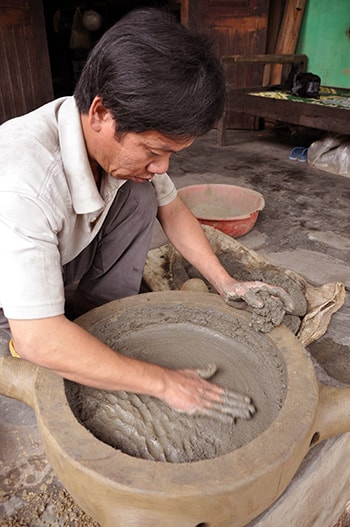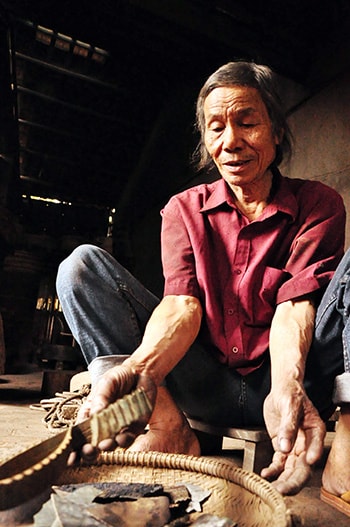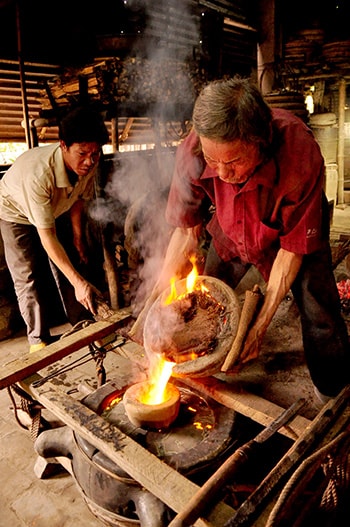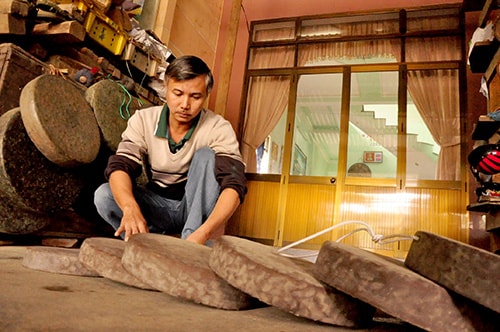Story about Phuoc Kieu bronze casting village
(QNO) - Locating beside National Highway 1A, in Dien Phuong Commune, Dien Ban District, Quang Nam Province, Phuoc Kieu village has been famous since hundreds of year in traditional craft of casting gongs and bronze products. The people in Quang Nam Province have a saying “Lam Yen drums and Phuoc Kieu gongs” to praise this land. Linking closely with quality of these original products and the existence of Phuoc Kieu casting village is 74 years old Folk Artisan Duong Ngoc Sang - an expert in adjusting the sound of gongs and a“living treasure” of the village…
 |
| Making mould is the first step of the bronze casting process. |
Travelling on the North-South national highway, when coming Dien Ban district we’ll see more than 20 bronze products shops standing along the road. Althought there are many kind of lurns and artworks for interior decoration which made from bronze being sold over here, however, most of them were produced in other provinces. The only original product which made Phuoc Kieu village famous in the country is gong – an important and necessary musical instrument to perform in holy ceremonies or cultural events of the ethnic minority peoples in mountainous areas and Central Highlands of Vietnam.
Historical documents showed that Phuoc village was built on a 6ha land- area in the time of the Nguyen Dinasty. People’s life and occupation based mainly on bronze casting craft. On the Great bell being kept at old man Duong Nhi’s house (Dong Kieu hamlet) engraved the time to cast this bell was 1820 (under King Minh Mang reign) and sentences to praise the excellent bronze casting talent of Phuoc Kieu’s artists. Under King Tu Duc reign, many talented casting workers of Phuoc Kieu village were invited to Hue imperial capital to cast coins, decorative artworks and household articles for royal family.
 |
| Linking closely with quality of these original products and the existence of Phuoc Kieu casting village is 74 years old Folk Artisan Duong Ngoc Sang-an expert in adjusting the sound of gongs and a“living treasure” of the village… |
The decade of 1970-1980 was the most prosperous period of Phuoc Kieu casting village with hundreds of visitors came to sight seeing, buy, try the gongs every day… Some of them invited Folk Artisan Duong Ngoc Sang to repair or adjust the sound of gongs. At that time, Phuoc Kieu people could make more than 200 tones of different products a year. Recently, artisans in the village successfully casted two bronze cannons similar to the ones used during the Nguyen Dynasty. Each cannon was 100kg in weight, 1.2m in length and 25cm in diameter
Nowaday, because of market competition and buyers’ demand is enough, the bronze products trading activity in Phuoc Kieu casting village has not been crowded and prosperous as before, the monthly income from casting work can’t be enough to breed workers’ family. The story about Folk Artisan Duong Ngoc Sang’s sound adjusting talent, however, like a legend.
Special low and high sounds from the bronze gongs bringing the breath of highlands forests have resounded almost everyday in Sang’s house. The bronze casting occupation in Phuoc Kieu village has not been improved as before, but some customers from remote places still came to his house to buy gongs. Some state organizations and individuals ordered and asked Sang to make Great bells.
We visited Mr Chin Sang (artist Duong Tan Sang’s friendly name) on a cold day of early spring at his bronze smelting furnace. The mould for casting with nearly half metre diameter being hotter and hotter in the fire of willow wood. A medium size pot for melting bronze putting beside also be ready to use with the help of an electric fan. Mr Chin Sang brought a tray of bronze pieces. Looking at the fire, he poured in all bronze pieces. About 20 minutes later, all bronze pieces were dissolved. Observing the colour of bronze, he decided to pour them in to a mould. The temperature of bronze at that time was 1,800 degree C.
 |
| Mr Chin Sang pouring dissolved bronze at 1,800 degree C into the mould. The worker doesn’t use a thermometer, they look at the colour of dissolved bronze to decide the time to cast. |
Half an hour later, Mr Chin Sang and his son opened the mould, and a crude gong with lumpy face was made and rolled on the floor. The bronze gong being made cool within the day, but the adjustment for accurate sound just be carried out after few days. The process of casting gongs was done mostly by hands. After casting, the moulds were kept carefully in a corner of the smelting furnace.
Many local people often said Mr Sang’s skill and ability for sound adjustment like a present given by the God, like a legend. Someone also said that by rehearing the recorded sound only, Mr Chin Sang could say correctly the time point of beating the gongs: in the morning, afternoon, evening or at noon and what material the gongs were made of.
More than 30 years going along with casting occupation, day after day, Mr Chin Sang listened to the sound of gongs which had been made by him and then doing a difficult work: to adjust the gong sound. Loving a assiduous student, Mr Sang’s ancestors taught him the ways of mixing material to make quality and enduring bronze products with good and interesting sound. Admiring Chin Sang’s talent, many people from ethnic minority hamlets in the Central Highlands and Binh Phuoc, Thua Thien - Hue provinces invited him to adjust their gongs. Recently, the State has granted Mr Sang the title “The Folk Artisan”...
 |
| Fully made 6, 8 gong-sets are ready to deliver to customers. They are casted by Mr Chin Sang and his son Duong Ngoc Cuong. |
Tieing the gong with a coconut string , Mr Chin Sang beats the gong lightly and then strongly, slowly and then fast, from the gong’s “navel” out to the breast… Looking at the face of a 30-40 centimetre diameter gong after each beating, Mr Sang can “see” the thin and thick measure of the gongs, can “hear” the magical changes of sound… After that, he begins adjusting the gong sound. It’s said that some people tried to pick up Sang’s casting method and experience, but they all failed because his real talent wasn’t tempered in any casting formulas, but from the ears and the hands.
Occasionally, Chin Sang and his son Duong Ngoc Cuong performed gong melodies of the Ede, Bana, Catu together. Understanding well gong melodies of these ethnic minority peoples was also a special talent of this father and son. “People from mountain area Tra My in Quang Nam province often run down the high sound when beating near the last part of a gong, but people in Lam Dong, Binh Phuoc provinces like this sound”, Chin Sang said. He also be able to made 6, 8 or 12 gong - set according to the customer’s demand, each gong has a different gamut. When being beaten simultaneously, they combine and create a perfect melody.
Folk Artisan Dương Ngọc Sang can not remember how many gong sets he has adjusted . But certainly one thing is that his name and talent has been recalled the most by chiefs of hamlets and villages of ethnic minorities peoples in the Central Highlands and provinces where he had come to. Many people afraid that in someday, the gong sound in Phuoc Kieu village will be ended because after the Folk Artisan’s life, there will not be anyone who can adjust the gong sound well like Sang!
By Doan Thanh Tri
